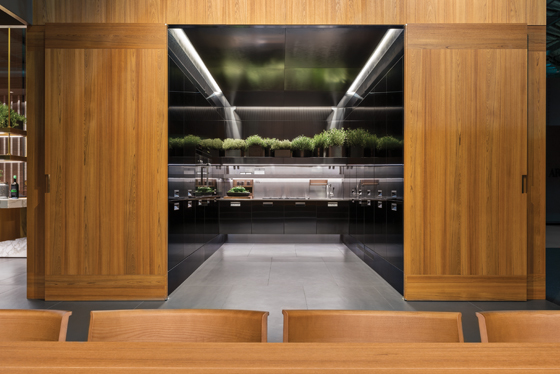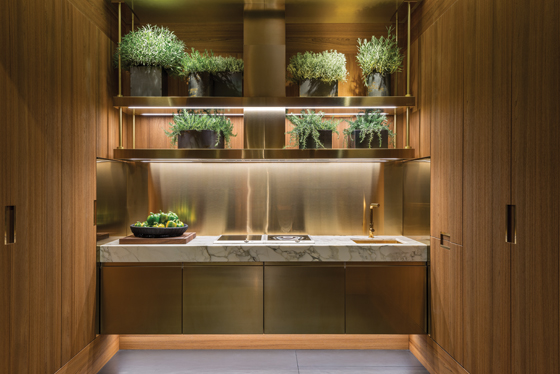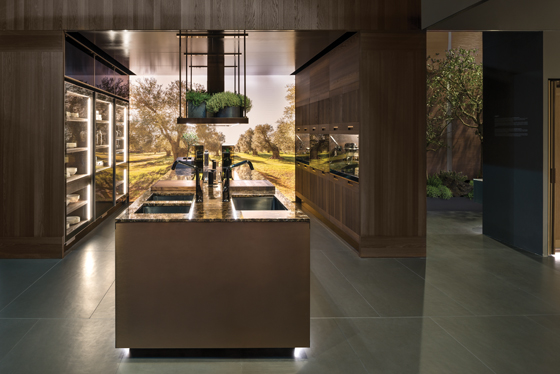Kitchen Stories
Historia de la marca de Dominic Lutyens
Caldogno (VI), Italia
18.05.16
Recent years have seen the kitchen become the non plus ultra of socialising spaces within the domestic sphere. Such a development is in no small part thanks to premium manufacturer ARCLINEA, which delivers kitchen environments that make you linger longer. Why bother with the rest of the house?
Originally designed by Antonio Citterio in 1988, Arclinea’s Italia kitchen lives on today with a glamorously contemporary bronze finish, thanks to the company’s innovative technological process, PVD (physical vapour disposition)
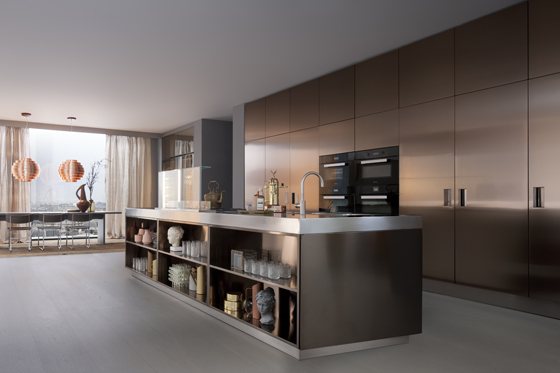
Originally designed by Antonio Citterio in 1988, Arclinea’s Italia kitchen lives on today with a glamorously contemporary bronze finish, thanks to the company’s innovative technological process, PVD (physical vapour disposition)
×Enter the world of Arclinea, and you find yourself in a practical and efficient, yet convivial and warm space. This long-established firm’s kitchens are never created in a social vacuum nor are they a hollow status symbol. Instead, they address real human needs. Arclinea’s designers carefully analyse evolving social habits to dream up spaces that satisfy our precise practical requirements and are conducive to the sensual and creative pleasures of cooking and eating.
Founded by Silvio Fortuna Senior in Caldogno, Veneto, in northeastern Italy in 1925, this family-run firm has been at the vanguard of kitchen design ever since. Milestones in its development include its creation of the first modular kitchen, first domestic kitchen incorporating features of a professional kitchen, and the ultra-modern notion of the kitchen as a multifunctional, fluid space to socialise in, not one divorced from the rest of the house. Arclinea’s long-standing collaboration with high-profile architect and designer Antonio Citterio has further cemented its reputation as an avant-garde brand.
Top: The Gamma30 (1970) catered to the 1970s taste for streamlined design. Above: Citterio’s 2002 Convivium open-plan kitchen abolished the convention of a separate room for cooking and dining

Top: The Gamma30 (1970) catered to the 1970s taste for streamlined design. Above: Citterio’s 2002 Convivium open-plan kitchen abolished the convention of a separate room for cooking and dining
×The culmination of Arclinea’s evolution and considerable know-how could be truly appreciated this year at its Eurocucina stand at the Salone del Mobile in Milan. Here, its new kitchen Principia, created by Citterio, could be seen in all its glory. Its highly original design juxtaposes antique-looking rough wood with stainless-steel finishes and a technological process Arclinea is rightly renowned for PVD (physical vapour disposition), which both binds colour to stainless steel via evaporation of titanium molecules and renders the steel harder and more resistant to wear and tear. Principia features handcrafted integrated handles, 84cm-high base units on 8-cm plinths, wood larders with glass doors and the wood Opus table, used as a presentation or peninsula table. Also on display was Arclinea’s Steelia finish created using PVD in fabulously opulent shades, some rarely encountered in kitchens – bronze, champagne, stainless steel and black. Also on display was the sumptuous Vanity collection, which incorporates subtle LED lighting, black quartz and smoked oak.
Two craftsmen in Arclinea’s carpentry workshop in 1943. The company then specialised in bespoke, hand-made wooden doors and windows for villas, hotels and shops

Two craftsmen in Arclinea’s carpentry workshop in 1943. The company then specialised in bespoke, hand-made wooden doors and windows for villas, hotels and shops
×Arclinea’s reputation for being cutting-edge springs from the highly original way it combines materials and from its engagement with state-of-the-art technology. Signature materials include specially textured wood that accentuates its natural qualities, laminates and stainless steel and Carrara marble.
New versions of classic Arclinea designs – Convivium, Italia and Lignum et Lapis – were also exhibited at Milan. This is hardly surprising since Arclinea values continuity and tradition. After all, it’s still based in the same spot where Silvio reopened the wood workshop founded in 1816 by his great-grandfather, naming it Fortuna Silvio. Even then, cooking was intimately tied to his family’s fortunes: Silvio’s parents, and later his wife Leonilda, too, ran a trattoria. In the early years, the firm supplied hand-made wooden doors and window frames to villas, hotels and shops. In the 1950s, Silvio’s children Angelo, Almerino and Lena joined the company, which at the time began creating furniture in a more contemporary, so-called ‘Swedish’ style and espoused large-volume production. In 1958, its first ultra-sleek, modular kitchen was born. In 1960, the business was renamed Arclinea, ‘Arc’ being an acronym for ‘arredamenti razionali componibili’ (modular rational furnishings). Propelling Arclinea towards greater success was Italy’s period of reconstruction after the Second World War, which saw the country’s economy grow and consumers increasingly hunger for contemporary design. An early pioneering Arclinea design was Claudia of 1963, the first kitchen with built-in electrical appliances and a stainless-steel hob. Aesthetics also played a key role, though: its doors and even the units’ slender feet were uniformly covered in elegant teak, an early sign of the company’s painstaking attention to detail.
Various Arclinea designs at Eurocucina 2016. Top: the Italia kitchen with black PVD finish and wood panelling. Middle, above: the Principia kitchen with tall teak doors, cantilevered base units and a sumptuous champagne PVD finish
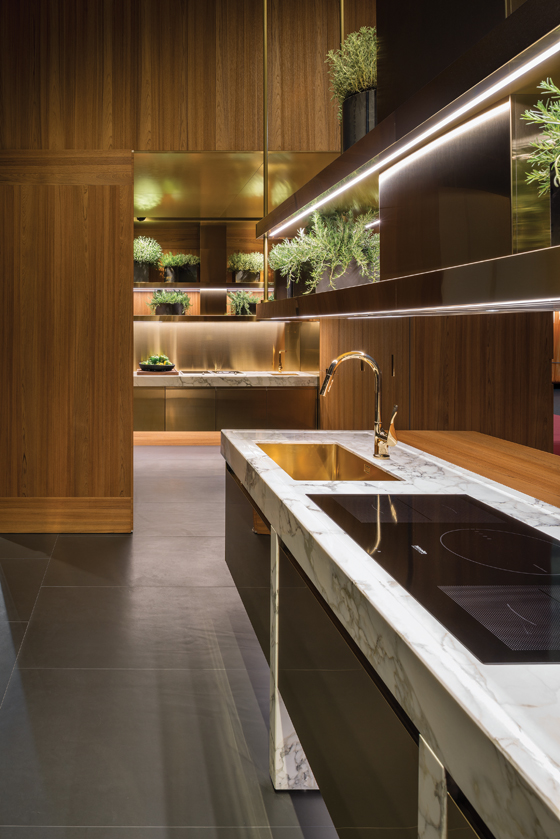
Various Arclinea designs at Eurocucina 2016. Top: the Italia kitchen with black PVD finish and wood panelling. Middle, above: the Principia kitchen with tall teak doors, cantilevered base units and a sumptuous champagne PVD finish
×In the 1970s, Arclinea confidently set new trends, notably with its Gamma30 kitchen, which, free of conventional handles, satisfied an emerging taste for streamlined, pared-down design. In the same decade, Arclinea – sensitive to a growing trend for people living in smaller spaces – instigated research into intelligent designs for kitchens in compact homes.
The 1980s ushered in a significant new chapter in the Arclinea story. Third-generation family members Silvio, Walter, Marillina and Gianni joined the firm, which began then to collaborate with freelance designers, whose input inevitably enriched Arclinea’s design culture. And no more so than Citterio, who was appointed the firm’s main designer in the late 1990s.
Top: the Principia kitchen with Isle base units and shimmering bronze PVD finish, the Opus table and two dressers in fossil oak. Middle and bottom: Another view of Principia, which harmoniously marries such materials as smoked oak and a bronze PVD finish
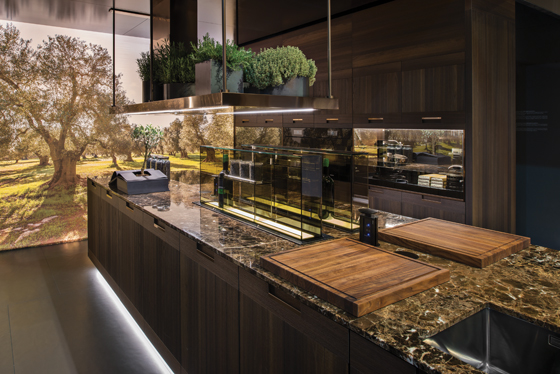
Top: the Principia kitchen with Isle base units and shimmering bronze PVD finish, the Opus table and two dressers in fossil oak. Middle and bottom: Another view of Principia, which harmoniously marries such materials as smoked oak and a bronze PVD finish
×Citterio’s first Arclinea design was the revolutionary Italia of 1988, which brought features from professional kitchens to the home – deep, expansive worktops, tall, spacious units and two sinks (one for food preparation, the other for washing dishes). A new version created in 2000 incorporated a highly practical island. Other iconic Citterio designs, all mirroring the latest trends, include the romantic-looking Mediterranea (1992), the funky, colourful Florida (1995) and clean-lined, minimalist Ginger (1997). Then in 2002, came the radically open-plan Convivium kitchen, which challenged the convention of a separate room for cooking and dining. Accompanying this was his innovative idea, the Closet – a walk-in, made-to-measure unit for washing and storing food. Soon Arclinea kitchens came with an ever-expanding family of convenient accessories – snack bars, ceiling-mounted extraction hoods, extensive tables, subtle lighting systems…
Incidentally, Arclinea’s kitchens are used in its international Arclinea Design Cooking School – further proof of their practicality and the firm’s indivisible relationship with food.
Arclinea’s philosophy is best expressed in Citterio’s own articulate words: ‘In recent years, the kitchen has taken on a central role in interior design,’ he says. ‘It used to be purely functional, tailored to suit the activities of a well-oiled machine. In time, however, it has become the heart of domestic socialising – welcoming, busy, energetic, open, familiar and flexible.’
Silvio Fortuna Senior, who founded Arclinea in Caldogno, Veneto in 1925. Back then, the Fortuna family had strong links with cooking since both Silvio’s parents and his wife Leonilda ran a trattoria
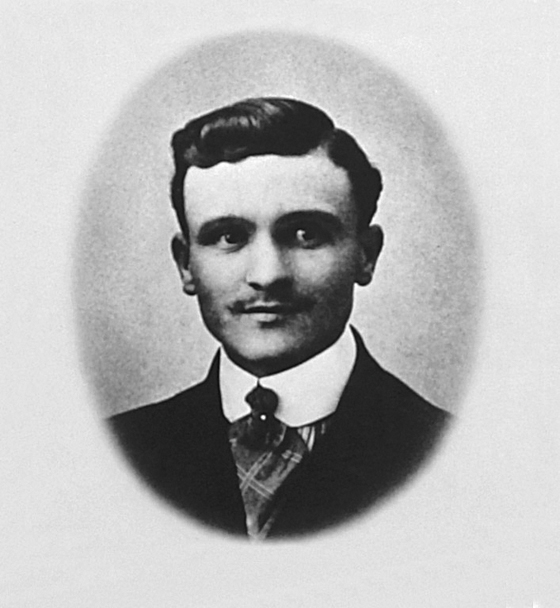
Silvio Fortuna Senior, who founded Arclinea in Caldogno, Veneto in 1925. Back then, the Fortuna family had strong links with cooking since both Silvio’s parents and his wife Leonilda ran a trattoria
ש Architonic






